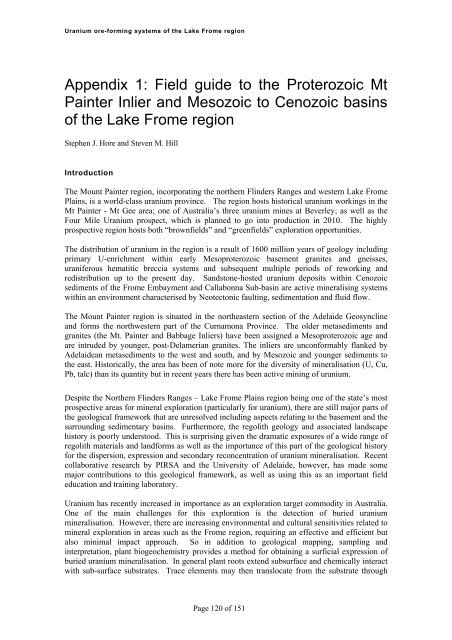Uranium ore-forming systems of the - Geoscience Australia
Uranium ore-forming systems of the - Geoscience Australia
Uranium ore-forming systems of the - Geoscience Australia
Create successful ePaper yourself
Turn your PDF publications into a flip-book with our unique Google optimized e-Paper software.
<strong>Uranium</strong> <strong>ore</strong>-<strong>forming</strong> <strong>systems</strong> <strong>of</strong> <strong>the</strong> Lake Frome regionAppendix 1: Field guide to <strong>the</strong> Proterozoic MtPainter Inlier and Mesozoic to Cenozoic basins<strong>of</strong> <strong>the</strong> Lake Frome regionStephen J. H<strong>ore</strong> and Steven M. HillIntroductionThe Mount Painter region, incorporating <strong>the</strong> nor<strong>the</strong>rn Flinders Ranges and western Lake FromePlains, is a world-class uranium province. The region hosts historical uranium workings in <strong>the</strong>Mt Painter - Mt Gee area; one <strong>of</strong> <strong>Australia</strong>’s three uranium mines at Beverley; as well as <strong>the</strong>Four Mile <strong>Uranium</strong> prospect, which is planned to go into production in 2010. The highlyprospective region hosts both “brownfields” and “greenfields” exploration opportunities.The distribution <strong>of</strong> uranium in <strong>the</strong> region is a result <strong>of</strong> 1600 million years <strong>of</strong> geology includingprimary U-enrichment within early Mesoproterozoic basement granites and gneisses,uraniferous hematitic breccia <strong>systems</strong> and subsequent multiple periods <strong>of</strong> reworking andredistribution up to <strong>the</strong> present day. Sandstone-hosted uranium deposits within Cenozoicsediments <strong>of</strong> <strong>the</strong> Frome Embayment and Callabonna Sub-basin are active mineralising <strong>systems</strong>within an environment characterised by Neotectonic faulting, sedimentation and fluid flow.The Mount Painter region is situated in <strong>the</strong> nor<strong>the</strong>astern section <strong>of</strong> <strong>the</strong> Adelaide Geosynclineand forms <strong>the</strong> northwestern part <strong>of</strong> <strong>the</strong> Curnamona Province. The older metasediments andgranites (<strong>the</strong> Mt. Painter and Babbage Inliers) have been assigned a Mesoproterozoic age andare intruded by younger, post-Delamerian granites. The inliers are unconformably flanked byAdelaidean metasediments to <strong>the</strong> west and south, and by Mesozoic and younger sediments to<strong>the</strong> east. Historically, <strong>the</strong> area has been <strong>of</strong> note m<strong>ore</strong> for <strong>the</strong> diversity <strong>of</strong> mineralisation (U, Cu,Pb, talc) than its quantity but in recent years <strong>the</strong>re has been active mining <strong>of</strong> uranium.Despite <strong>the</strong> Nor<strong>the</strong>rn Flinders Ranges – Lake Frome Plains region being one <strong>of</strong> <strong>the</strong> state’s mostprospective areas for mineral exploration (particularly for uranium), <strong>the</strong>re are still major parts <strong>of</strong><strong>the</strong> geological framework that are unresolved including aspects relating to <strong>the</strong> basement and <strong>the</strong>surrounding sedimentary basins. Fur<strong>the</strong>rm<strong>ore</strong>, <strong>the</strong> regolith geology and associated landscapehistory is poorly understood. This is surprising given <strong>the</strong> dramatic exposures <strong>of</strong> a wide range <strong>of</strong>regolith materials and landforms as well as <strong>the</strong> importance <strong>of</strong> this part <strong>of</strong> <strong>the</strong> geological historyfor <strong>the</strong> dispersion, expression and secondary reconcentration <strong>of</strong> uranium mineralisation. Recentcollaborative research by PIRSA and <strong>the</strong> University <strong>of</strong> Adelaide, however, has made somemajor contributions to this geological framework, as well as using this as an important fieldeducation and training laboratory.<strong>Uranium</strong> has recently increased in importance as an exploration target commodity in <strong>Australia</strong>.One <strong>of</strong> <strong>the</strong> main challenges for this exploration is <strong>the</strong> detection <strong>of</strong> buried uraniummineralisation. However, <strong>the</strong>re are increasing environmental and cultural sensitivities related tomineral exploration in areas such as <strong>the</strong> Frome region, requiring an effective and efficient butalso minimal impact approach. So in addition to geological mapping, sampling andinterpretation, plant biogeochemistry provides a method for obtaining a surficial expression <strong>of</strong>buried uranium mineralisation. In general plant roots extend subsurface and chemically interactwith sub-surface substrates. Trace elements may <strong>the</strong>n translocate from <strong>the</strong> substrate throughPage 120 <strong>of</strong> 151
















